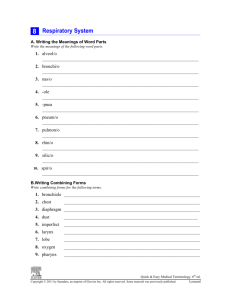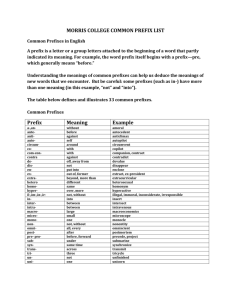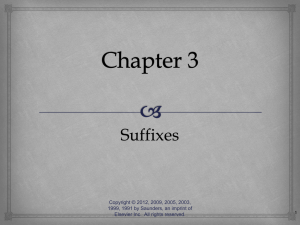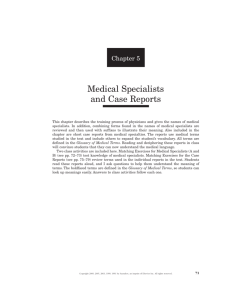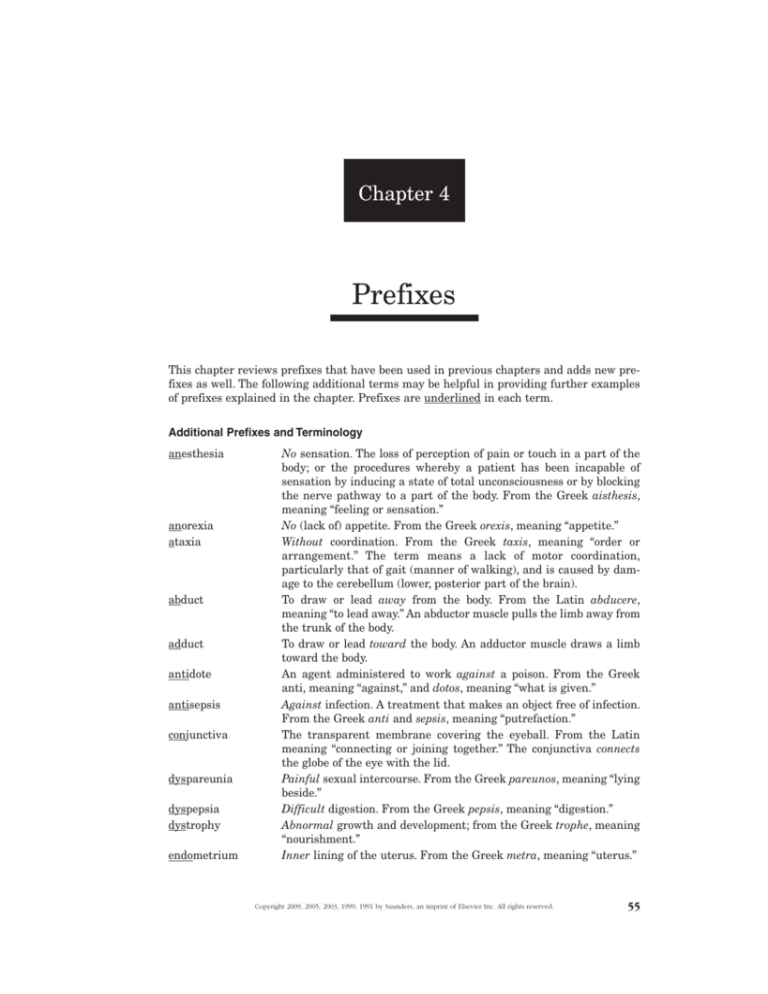
Chapter 4
Prefixes
This chapter reviews prefixes that have been used in previous chapters and adds new prefixes as well. The following additional terms may be helpful in providing further examples
of prefixes explained in the chapter. Prefixes are underlined in each term.
Additional Prefixes and Terminology
anesthesia
anorexia
ataxia
abduct
adduct
antidote
antisepsis
conjunctiva
dyspareunia
dyspepsia
dystrophy
endometrium
No sensation. The loss of perception of pain or touch in a part of the
body; or the procedures whereby a patient has been incapable of
sensation by inducing a state of total unconsciousness or by blocking
the nerve pathway to a part of the body. From the Greek aisthesis,
meaning “feeling or sensation.”
No (lack of) appetite. From the Greek orexis, meaning “appetite.”
Without coordination. From the Greek taxis, meaning “order or
arrangement.” The term means a lack of motor coordination,
particularly that of gait (manner of walking), and is caused by damage to the cerebellum (lower, posterior part of the brain).
To draw or lead away from the body. From the Latin abducere,
meaning “to lead away.” An abductor muscle pulls the limb away from
the trunk of the body.
To draw or lead toward the body. An adductor muscle draws a limb
toward the body.
An agent administered to work against a poison. From the Greek
anti, meaning “against,” and dotos, meaning “what is given.”
Against infection. A treatment that makes an object free of infection.
From the Greek anti and sepsis, meaning “putrefaction.”
The transparent membrane covering the eyeball. From the Latin
meaning “connecting or joining together.” The conjunctiva connects
the globe of the eye with the lid.
Painful sexual intercourse. From the Greek pareunos, meaning “lying
beside.”
Difficult digestion. From the Greek pepsis, meaning “digestion.”
Abnormal growth and development; from the Greek trophe, meaning
“nourishment.”
Inner lining of the uterus. From the Greek metra, meaning “uterus.”
Copyright 2009, 2005, 2003, 1999, 1991 by Saunders, an imprint of Elsevier Inc. All rights reserved.
55
56
epiglottis
exophthalmos
malaise
prodrome
trimester
ultraviolet
INSTRUCTOR’S RESOURCE MANUAL WITH TEACH LESSON PLANS FOR MEDICAL TERMINOLOGY: A SHORT COURSE
The flap of cartilage above the entrance to the trachea. The structure
was once thought of as an appendage of the tongue. From the Greek
glossa, meaning “tongue.”
Protruding (“out”) eyeball. Exophthalmic goiter is a condition of
enlargement of the thyroid gland associated with bulging of the white
of the eye (sclera).
A vague feeling of bodily discomfort. From the French mal, meaning
“bad” or “ill,” and aise, meaning “ease.”
Early stage of an illness; that which “runs before.” From the Greek
dromos, meaning “running.”
The equally divided early, middle, and late stages of pregnancy.
The term means a period of three months, from mestris, meaning
“monthly.”
Of a wavelength above and beyond that of visible violet light.
Copyright 2009, 2005, 2003, 1999, 1991 by Saunders, an imprint of Elsevier Inc. All rights reserved.
Name
Handout 4.1
Chapter 4 Multiple Choice Quiz
❏
❏
❏
❏
❏
❏
1. Not able to breathe:
A. atrophy
B. tachypnea
C. dysplasia
D. dyspnea
E. apnea
2. Before birth:
A. antigen
B. antepartum
C. postpartum
D. postnatal
E. neonatal
3. Deficiency in red blood cells or
of the hemoglobin within the red
cells:
A. aphasia
B. amenorrhea
C. anemia
D. apnea
E. dysplasia
4. Excessive (more than normal)
development:
A. hypoplasia
B. dysplasia
C. atrophy
D. hypertrophy
E. neoplastic
5. A return of symptoms of illness:
A. remission
B. resection
C. prolapse
D. prosthesis
E. relapse
6. Difficult, painful urination:
A. urinalysis
B. dysuria
C. polyuria
D. hematuria
E. uremia
❏
❏
❏
7. A protein made by white blood
cells and capable of destroying
bacteria and viruses:
A. antibody
B. antibiotic
C. antigen
D. hemoglobin
E. leukocyte
8. An irregularity that occurs at
birth:
A. intrauterine
B. neonatal
C. benign
D. congenital anomaly
E. ectopic pregnancy
9. Slow heartbeat:
A. bradycardia
B. tachypnea
C. cardiomegaly
D. myocardial infarction
E. tachycardia
❏
10. An artificial part:
A. metacarpal
B. epidermis
C. prosthesis
D. anomaly
E. intervertebral disk
❏
11. Pertaining to under the shoulder
bone:
A. subcostal
B. hypodermic
C. subdural
D. epidural
E. subscapular
❏
12. Pertaining to both (two) sides:
A. unilateral
B. tricuspid
C. intravenous
D. sagittal
E. bilateral
Copyright 2009, 2005, 2003, 1999, 1991 by Saunders, an imprint of Elsevier Inc. All rights reserved.
57
❏
❏
❏
❏
❏
❏
13. Process of recording sound
waves to make an image of
organs in the body:
A. CT scan
B. ultrasonography
C. MRI
D. endoscopy
E. dialysis
14. Endocrine glands that are near
(above) each kidney:
A. adrenal
B. prostate
C. subcostal
D. parathyroid
E. transurethral
15. The spread of a cancerous tumor
to another organ away from the
original location:
A. subcutaneous
B. carcinoma
C. neoplastic
D. metastasis
E. malignant
❏
16. Two prefixes that mean
“beyond”:
A. tachy- and bradyB. pro- and preC. dys- and malD. re- and retroE. ultra- and meta-
❏
17. A word that means “complete
separation” and is the process
of separating wastes from the
blood:
A. dialysis
B. diarrhea
C. urinalysis
D. syndrome
E. subcutaneous
58
18. A membrane that surrounds
bone:
A. pericardium
B. peritoneum
C. epidermis
D. subcostal
E. periosteum
19. A prefix that has the same
meaning as “ante” is:
A. a-, anB. antiC. proD. adE. pan20. Poly- has a similar meaning
with:
A. reB. dysC. synD. hyperE. hypo-
❏
21. A group of symptoms that occur
together is called a(an):
A. analysis
B. syndrome
C. dialysis
D. prognosis
E. remission
❏
22. A prefix that means “near, along
the side of” is:
A. neoB. proC. periD. paraE. dia-
Copyright 2009, 2005, 2003, 1999, 1991 by Saunders, an imprint of Elsevier Inc. All rights reserved.
❏
23. An abnormal collection of blood
above the membrane covering
the brain:
A. subdural hematoma
B. cerebral hemorrhage
C. thrombosis
D. epidural hematoma
E. subdural hemorrhage
❏
24. Two prefixes that mean “within”:
A. ante- and proB. endo- and intraC. hypo- and subD. syn- and conE. extra- and ec-
❏
25. If an organ slides or falls
forward, the condition is called:
A. neoplasm
B. relapse
C. remission
D. prolapse
E. dysmenorrhea
Copyright 2009, 2005, 2003, 1999, 1991 by Saunders, an imprint of Elsevier Inc. All rights reserved.
59
Name
Handout 4.2
Chapter 4 Spelling and Comprehension Quiz
I. Spelling
1.
11.
2.
12.
3.
13.
4.
14.
5.
15.
6.
16.
7.
17.
8.
18.
9.
19.
10.
20.
II. Comprehension: Match the terms listed above with their meanings below.
within the uterus
difficult breathing
pertaining to a newborn
painful urination
after birth
spread of a cancerous (malignant tumor)
low blood sugar
collection of blood above a meningeal layer
excessive development
discharge of fluid from the rectum
slow heartbeat
loss of movement due to nerve damage
between a backbone
embryo is not in the proper location
pertaining to one side
abnormal growth or development
harmless, noncancerous
falling down; drooping of a part of the body
artificial part attached to the body
cancerous; harmful
60
Copyright 2009, 2005, 2003, 1999, 1991 by Saunders, an imprint of Elsevier Inc. All rights reserved.
III. Match the term in Column I with its meaning in Column II.
Column I
1. metacarpal
2. remission
3. subscapular
4. perianal
5. relapse
6. subcostal
7. periosteum
8. retroperitoneal
9. congenital anomaly
10. antigen
Column II
A. behind the abdominal cavity
B. below the shoulder blade
C. membrane surrounding a bone
D. abnormality present at birth
E. foreign body; bacteria, virus
F. symptoms of disease return
G. pertaining to surrounding the anus
H. symptoms of disease disappear
I. under the ribs
J. hand bone
Copyright 2009, 2005, 2003, 1999, 1991 by Saunders, an imprint of Elsevier Inc. All rights reserved.
61
Name
Handout 4.3
Review Quiz
I. Give meanings for the following prefixes:
1. ante-
9. intra-
2. anti-
10. post-
3. epi-
11. meta-
4. ab-
12. hypo-
5. ad-
13. para-
6. hemi-
14. syn-
7. hyper-
15. mal-
8. interII. Give prefixes for the following English terms:
1. one
5. surrounding
2. two
6. new
3. three
7. fast
4. four
8. slow
III. Give meanings for the following suffixes:
1. -pnea
9. -pathy
2. -tension
10. -rrhea
3. -uria
11. -stasis
4. -dipsia
12. -mortem
5. -gen
13. -plasm
6. -emia
14. -graphy
7. -lysis
15. -tic
8. -partum
62
Copyright 2009, 2005, 2003, 1999, 1991 by Saunders, an imprint of Elsevier Inc. All rights reserved.
Name
Handout 4.4
Chapter 4 Crossword Puzzle Quiz
1
2
3
4
5
6
7
8
9
10
11
12
Across
3. prefix meaning below or deficient
5. prefix meaning against
6. prefix meaning beyond
7. prefix meaning between
8. slow discharge of urine
10. prefix meaning up or apart
11. prefix meaning slow
12. benign tumor of bone
Down
1. pertaining to new birth
2. rapid breathing
3. prefix meaning above or excessive
4. surrounding the anus
5. prefix meaning before
9. painful breathing
Copyright 2009, 2005, 2003, 1999, 1991 by Saunders, an imprint of Elsevier Inc. All rights reserved.
63
64
INSTRUCTOR’S RESOURCE MANUAL WITH TEACH LESSON PLANS FOR MEDICAL TERMINOLOGY: A SHORT COURSE
Handout 4.5
Chapter 4 Medical Word Doctor
Using combinations of the following combining forms, suffixes and prefixes create a term to
complete the following scenarios.
Remember that while all medical terms contain suffixes, there are suffixes that contain
roots.
Combining Forms
Suffixes
Prefixes
aden/o
cutane/o
men/o
nat/i
neur/o
phas/o
ren/o
vertebr/o
-al
-ia
-ous
-pathy
-pnea
-rrhea
-stasis
-thesis
aaddysintermetapolypreprossubtachy-
1. Your patient with diabetes must learn to inject insulin under the skin and into the
tissue.
2. An extremely elevated temperature that sometimes occurs in infectious diseases,
especially in young children, may be accompanied by rapid breathing, known as
.
3. The tingling and painful sensations in Paula’s arm seem to point to disease of many
nerves, called
.
4. When the sarcoma spread from Bill’s leg to his liver, you discussed the implications of
the
as it related to his prognosis.
5. Every month, Carol had pain with her menstrual period. Her
was uncomfortable, but she was able to go to work and take care of her family.
6. After Scott returned from Iraq, he had surgery to remove his injured leg. He was then
fitted for a
.
7. Pregnant women should take
vitamins during their pregnancy.
Copyright 2009, 2005, 2003, 1999, 1991 by Saunders, an imprint of Elsevier Inc. All rights reserved.
INSTRUCTOR’S RESOURCE MANUAL WITH TEACH LESSON PLANS FOR MEDICAL TERMINOLOGY: A SHORT COURSE
8. The pain in Carl’s back was related to a bulging
65
disc
pressing on a nerve in his spinal cord.
9. The
glands are located near (above) each kidney. They secrete
hormones that increase heart rate and blood pressure, and regulate salt and sugar in
the body.
10. After Sally’s stroke, which caused damage to her left cerebral cortex, she developed
and could not speak.
Copyright 2009, 2005, 2003, 1999, 1991 by Saunders, an imprint of Elsevier Inc. All rights reserved.
66
INSTRUCTOR’S RESOURCE MANUAL WITH TEACH LESSON PLANS FOR MEDICAL TERMINOLOGY: A SHORT COURSE
Chapter 4 Answers
Multiple Choice
II. Comprehension
Handout 4.1
1.
2.
3.
4.
5.
6.
7.
8.
9.
10.
11.
12.
13.
E
B
C
D
E
B
A
D
A
C
E
E
B
14.
15.
16.
17.
18.
19.
20.
21.
22.
23.
24.
25.
A
D
E
A
E
C
D
B
D
D
B
D
Spelling and Comprehension Quiz
Handout 4.2
I. Spelling Words
1.
2.
3.
4.
5.
6.
7.
8.
9.
10.
11.
12.
13.
14.
15.
16.
17.
18.
19.
20.
benign
bradycardia
diarrhea
dysplasia
dyspnea
dysuria
ectopic pregnancy
epidural hematoma
hypertrophy
hypoglycemia
intervertebral
intrauterine
malignant
metastasis
neonatal
paralysis
postpartum
prolapse
prosthesis
unilateral
12
5
15
6
17
14
10
8
9
3
2
16
11
7
20
4
1
18
19
13
within the uterus
difficult breathing
pertaining to a newborn
painful urination
after birth
spread of a cancerous (malignant) tumor
low blood sugar
collection of blood above a meningeal
layer
excessive development
discharge of fluid from the rectum
slow heartbeat
loss of movement due to nerve damage
between a backbone
embryo is not in the proper location
pertaining to one side
abnormal growth or development
harmless, noncancerous
falling down; drooping of a part of the
body
artificial part attached to the body
cancerous; harmful
III. Matching
1.
2.
3.
4.
5.
6.
7.
8.
9.
10.
J
H
B
G
F
I
C
A
D
E
Copyright 2009, 2005, 2003, 1999, 1991 by Saunders, an imprint of Elsevier Inc. All rights reserved.
INSTRUCTOR’S RESOURCE MANUAL WITH TEACH LESSON PLANS FOR MEDICAL TERMINOLOGY: A SHORT COURSE
Review Quiz
Handout 4.3
I. 1.
2.
3.
4.
5.
6.
7.
8.
9.
10.
11.
12.
13.
14.
15.
II. 1.
2.
3.
4.
5.
6.
7.
8.
III. 1.
2.
3.
4.
5.
6.
7.
8.
9.
10.
11.
12.
13.
14.
15.
before, forward
against
above, upon
away from
toward; near
half
excessive, above
between
within
after, behind
change; beyond
below, under
beside, near, along the side of
with, together
bad
unibitriquadriperineotachybradybreathing
pressure
urine condition
thirst
to produce
blood condition
loosening, breakdown, separation, destruction
birth
disease condition
flow, discharge
to stand, place, stop, control
death
formation
process of recording
pertaining to
Copyright 2009, 2005, 2003, 1999, 1991 by Saunders, an imprint of Elsevier Inc. All rights reserved.
67
68
INSTRUCTOR’S RESOURCE MANUAL WITH TEACH LESSON PLANS FOR MEDICAL TERMINOLOGY: A SHORT COURSE
Crossword Puzzle Quiz
Handout 4.4
1
N
6
2
B
A
H Y
T A
Y
O
C
P
R A
H
E
N
L
E
11
B R
5
P O
A N T
E
N
R
T
I
N T
I
E R
A
N
P
N A
4
7
D Y U R I
T
10
3
M E
N
8
T
9
D
A D Y
L
A
S
P
N
12
O S
T E
O M A
A
Medical Word Doctor
Handout 4.5
1.
2.
3.
4.
5.
6.
7.
8.
9.
10.
subcutaneous
tachypnea
polyneuropathy
metastasis
dysmenorrhea
prosthesis
prenatal
intervertebral
adrenal
aphasia
Copyright 2009, 2005, 2003, 1999, 1991 by Saunders, an imprint of Elsevier Inc. All rights reserved.
INSTRUCTOR’S RESOURCE MANUAL WITH TEACH LESSON PLANS FOR MEDICAL TERMINOLOGY: A SHORT COURSE
69
Dictation Sentences
Medical terms that are in bold are found in the chapter. Italicized terms may be new to
students. Their definitions follow the paragraph.
1. Endocrine Glands
Endocrine glands secrete hormones through the bloodstream, directly affecting the
function of organs. Examples of endocrine glands are the adrenal glands, parathyroid
glands, thyroid gland, pituitary gland, and pancreas. Hyperthyroidism is a condition of
excessive secretion of thyroid hormone. Hyperglycemia is a high blood sugar level caused
by deficient secretion of the hormone insulin from the pancreas.
2. Malignant Tumors
There are two types of malignant tumors, carcinomas and sarcomas. Carcinomas are
cancerous tumors arising from epithelial cells, which are lining cells in internal organs
such as the lung, urinary bladder, gastrointestinal tract, and glands. Often, these cancerous
tumors are called adenocarcinomas. Sarcomas arise from connective tissues, such as
muscle, bone, cartilage, and fat. An example of a sarcoma is an osteosarcoma. The main
characteristic of a malignant neoplasm is metastasis. If the tumor is treated with
resection, chemotherapy, and/or radiotherapy, remission and cure are possible. If relapse
occurs, the patient may require further treatment.
Osteosarcoma: malignant tumor of bone
3. Congenital Anomaly
A congenital anomaly is a birth defect. Examples of neonatal abnormalities include
Down syndrome, hip dysplasia, sickle cell anemia, heart defects, and spina bifida, which
may involve paralysis. If the congenital anomaly arises from the genes in egg and
sperm cells, it is hereditary. If it arises from the antenatal intrauterine environment, it
is acquired.
Hereditary: a condition transmitted from parent to offspring via genes
Spina bifida: a congenital defect of the spine in which there is a gap in the vertebrae that
causes outward bulging of the spinal cord and/or meninges
Copyright 2009, 2005, 2003, 1999, 1991 by Saunders, an imprint of Elsevier Inc. All rights reserved.




